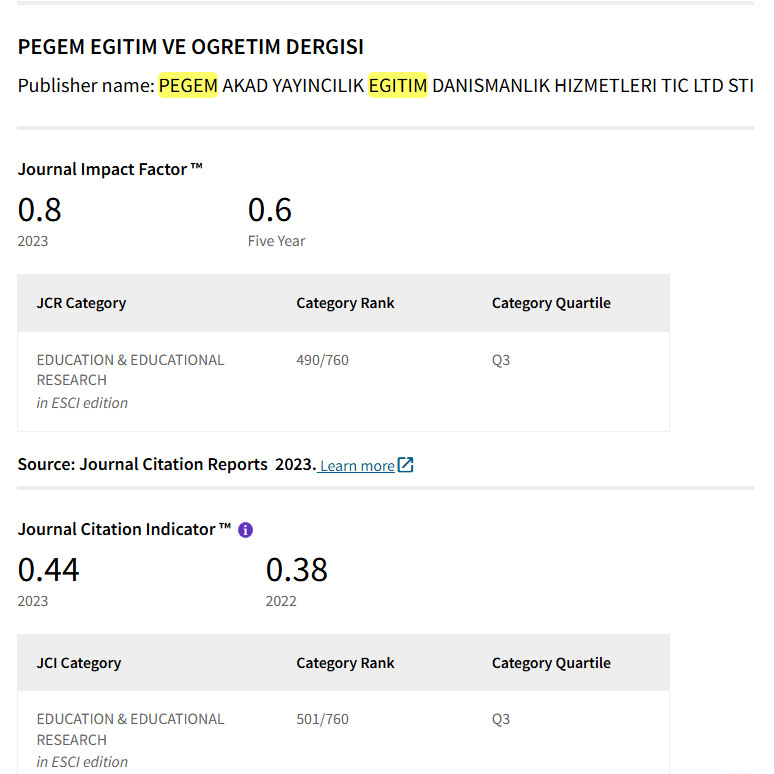Students' Digital Learning Resources for Transversal Skills Improvement and Virtues Inculcation
DOI:
https://doi.org/10.47750/pegegog.14.02.02Keywords:
Digital technologies, cooperation, digital competence, cognitive engagementAbstract
The goal of the study is to analyse the relation between students' digital learning and transversal skills, as well as between students' digital learning and virtues. In the correlative study, 73 teachers of Class 12 of general education institutions participated, filling out a questionnaire in the Google Docs environment. As a result of the theoretical analysis, the criteria for digital learning have been identified - access to digital technologies, cooperation, teachers’ digital competence and availability of activities in compliance with cognitive engagement levels. The findings of the correlation analysis show that the availability of activities in compliance with cognitive engagement levels is the most important in the development of transversal skills, while in the inculcation of virtues - cooperation. The access to digital technologies has a statistically significant correlation with both transversal skills and virtues. The teachers’ digital competence promotes digital literacy and such virtues as responsibility and wisdom. The recommendations developed as part of the study include compilation and promotion of the positive experiences of digital learning at the state and local government level; continuous monitoring and feedback analysis of purposeful digital learning and educational quality at school and classroom level; the application of digital learning resources based on the offer of activities in compliance with the students' cognitive engagement levels at the personal level.
Downloads
References
Alasa, V., Viavia, M., Shirotriya, A., & Devi, R. (2022). The Impact of Digital Learning during the Covid-19 pandemic on Tertiary Education Students in Fiji. Journal of Language and Linguistic Studies, 18(2), 1335-1351. https://www.researchgate.net/publication/359256029_The_Impact_of_Digital_Learning_during_the_Covid-19_pandemic_on_Tertiary_Education_in_Fiji
Basak, S.K., Wotto, M., & Bélanger, P. (2018). E-learning, M-learning and D-learning: Conceptual definition and comparative analysis. E-Learning and Digital Media, 15(4), 191–216. https://doi.org/10.1177/2042753018785
Beal, C.R., & Cohen, P.R. (2012). Teach Ourselves: Technology to Support Problem Posing in the STEM Classroom. Creative Education, 3(4), 513-519. https://doi.org/10.4236/ce.2012.34078
Bersin, J. (2017). How do you define digital learning? https://www.clomedia.com/2017/06/11/%20define-digital-learning/
Blundell, C., Lee, K-T., & Nykvist, S. (2016). Digital learning in schools: Conceptualizing the challenges and influences on teacher practice. Journal of Information Technology Education: Research, 15, 535-560. https://www.informingscience.org/Publications/3578
Camilleri, A.C. (2015). Digital Learning Resources in Education. LAP LAMBERT Academic Publishing. https://www.amazon.com/Learning-Resources-Education-Caterina-Camilleri/dp/365976048X
Chi, M. T. (2009). Active-constructive-interactive: A conceptual framework for differentiating learning activities. Topics in Cognitive Science, 1(1), 73e105. https://doi.org/10.1111/j.1756-8765.2008.01005.x
Dochevska, Y. (2020). Transversal Skills Correlation to Online Education. Pedagogy, 92(7), 47-55. https://azbuki.bg/wp-content/uploads/2020/09/NSA-Yoanna-Dochevksa.pdf
Komalasari, K., Fitriasari, S., & Anggraini, D.N. (2021). Living Values-Based Digital Learning Resources in Civic Education. The New Educational Review, 85-96. https://doi.org/10.15804/tner.21.63.1.07
Leek, J., & Rojek, M. (2022). Functions of digital learning within the international mobility programme – perspectives of university students and staff from Europe. Education and Information Technologies, 27, 6105–6123. https://link.springer.com/article/10.1007/s10639-021-10855-y
Martinsone, K., Pipere, A., Kamerade, D. (2016). Research: Theory and Practice. Riga: RaKa. https://www.researchgate.net/publication/312096048_Petnieciba_teorija_un_prakse_Research_theory_and_practice
PISA 2015 results (volume V): Collaborative problem solving. (2017). OECD Publishing. https://doi.org/10.1787/9789264285521-en
Pate, S. R. (2019). Effect of Digital Learning on Secondary school students. Etap Career Advisor, 23-26. https://www.researchgate.net/publication/339898989_Effect_of_Digital-learning_on_Academic_achievement_of_secondary_school_students
Pentang, J. T. (2021). Technological dimensions of globalization across organizations: Inferences for instruction and research. International Educational Scientific Research Journal, 7(7), 28-32. https://doi.org/10.2139/ssrn.3896459
Regulations No 416 Regarding the State General Secondary Education Standard and Model General Secondary Education Programmes. (2019). https://likumi.lv/ta/en/en/id/309597
Sailer, M., Murbὂck, J., & Fischer, F. (2021). Digital learning in schools: What does it take beyond digital technology? Teaching and Teacher Education, 103, 103346. https://doi.org/10.1016/j.tate.2021.103346
Seufert, S., Guggemos, J., & Sailer, M. (2021). Technology-related knowledge, skills, and attitudes of pre- and in-service teachers: The current situation and emerging trends. Computers in Human Behavior, 115, 106552. https://doi.org/10.1016/j.chb.2020.106552
VanderArk, T., & Schneider, C. (2012). How Digital Learning Contributes to Deeper Learning. https://library.educause.edu/-/media/files/library/2012/12/csd6152a-pdf.pdf
Witt, G.L., & Baird, D.E. (2018). The Gen Z Frequency: How Brands Tune In and Build Credibility. United Kingdom: London. https://www.debaird.net/blendededunet/the-gen-z-frequency-derek-baird-how-brands-tune-in-and-build-credibility.html
Downloads
Published
How to Cite
Issue
Section
License
Copyright (c) 2023 Pegem Journal of Education and Instruction

This work is licensed under a Creative Commons Attribution-NonCommercial 4.0 International License.
Attribution — You must give appropriate credit, provide a link to the license, and indicate if changes were made. You may do so in any reasonable manner, but not in any way that suggests the licensor endorses you or your use.
NonCommercial — You may not use the material for commercial purposes.
No additional restrictions — You may not apply legal terms or technological measures that legally restrict others from doing anything the license permits.



